
|
Assyrian Dagger In Bronze
|
|
Ancient Assyrian dagger in bronze. Museum of Berlin. |

|
Assyrian Poignard With Head Of Hippopotamus
|
|
Ancient Assyrian poignard with head of hippopotamus, probably in bronze. From the bas-relief of Nimrod B.C. 1000. |

|
Babylonian Dagger In Bronze
|
|
Ancient Babylonian dagger in bronze. British Museum. |

|
Assyrian Dagger In Bronze
|
|
Ancient Assyrian dagger in bronze. From the Museums of the Louvre and of Berlin. |
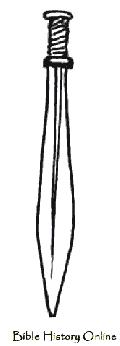
|
Egyptian Bronze Dagger
|
|
Ancient Egyptian bronze dagger that has Greek character. 14 inches. |
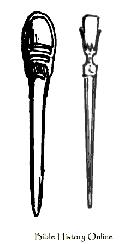
|
Egyptian Poignard And Sheath
|
|
Egyptian bronze poignard and sheath. 1 foot in length, handle is of ivory, ornamented with studs in gilded bronze from Museum of Berlin. |
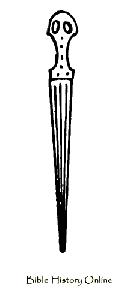
|
Bronze Egyptian Poignard
|
|
Bronze Egyptian poignard, 11 1/2 inches found at Thebes. Handle is in horn. |

|
Egyptian Poignard In Bronze
|
|
Egyptian poignard in bronze. The handle is fixed upon a wooden core. |

|
Antique Greek Dagger Called Parazonium
|
|
Antique Greek dagger called parazonium. Common to Greeks and Romans, 16 4/5 inches long. From Museum of Artillery, Paris. |

|
Egyptian Sword Breaker
|
|
Ancient Egyptian sword-breaker. A sturdy dagger used as sidearm to break swords. |
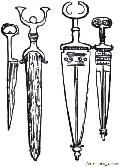
|
Four German Daggers
|
|
Four ancient German daggers or poniards. From Museum at Sigmaringen. |

|
Danish Dagger
|
|
Danish dagger in bronze. 14 1/2 inches in length. Bronze Age. From the Copenhagen Museum. |

|
Bronze Danish Dagger
|
|
Danish dagger in bronze, 8 1/2 inches in length. Bronze Age. From Copenhagen Museum. |

|
Danish Poniard
|
|
Danish poniard in bronze, 4 inches long. From the Copenhagen Museum. |
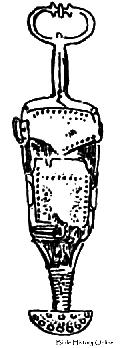
|
Germanic Poniard In Iron
|
|
Germanic poniard in iron, 15 inches length. Found in a tomb in Bavaria. From Museum of Sigmaringen. |

|
Frankish Dagger Or Semispata In Iron Called Scramasax
|
|
Frankish dagger or semispata in iron called scramasax. Has a single edge, and several grooves on the back of the blade. 24 inches length including the haft. From Museum of Artillery in Paris. |

|
Scramasax In Iron Found In Switzerland
|
|
Scramasax in iron, 18 inches in length found in Switzerland. |

|
Scramasax In Iron
|
|
Scramasax in iron. Length of blade is 15inches and of haft 8 inches found at Wulflingen and preserved in the Museum of Sigmaringen. Distinct for having a small knife attached on the outside of the sheath. |

|
Germanic Dagger Of The Merovingian Epoch
|
|
Germanic dagger of the Merovingian epoch, 17 inches length. Found in a tomb at Hettingen and preserved in the Sigmaringen Museum. |

|
Germanic Dagger Of The Merovingian Epoch Found At Rothenlachen
|
|
Germanic dagger of the Merovingian epoch, found at Rothenlachen and preserved in the Museum of Sigmaringen. 8 1/2 inches in length. This shape was used for more than 800 years, for it is to be found in the 15th century. |

|
Germanic Dagger-Knife
|
|
Germanic dagger-knife of the Merovingian epoch. 13 1/2 inches. Rare specimen on account of its shape. Found in a tomb near Sigmaringen. |

|
10th Century British Cutlass Attributed To Edward II
|
|
10th century British cutlass. It is attributed to Edward II. From Machel Manuscript. |

|
13th Century Iron Dagger
|
|
Iron dagger, about a foot long, 13th century. In the Museum of the Canton, Lausanne. |

|
13th Century Iron Dagger
|
|
13th century iron dagger. The blade of which measures about 12, and the haft about 5 inches. In the Museum of the Canton, Lausanne. |

|
14th Century Scottish Iron Poniards
|
|
14th century Scottish iron poniards. In the Collection of Prince Charles of Prussia. |

|
Poniard From The Beginning Of The 14th Century
|
|
Poniard from the beginning of the 14th century. |

|
Iron Dagger Of The 14th Century
|
|
Iron dagger of the 14th century. About 14 inches in length. The haft is very long. In the Museum of the Canton, Lausanne. |

|
14th Century Iron Dagger
|
|
End of the 14th century iron dagger, about 19 1/2 inches long. In the Tower of London. |

|
End Of The 14th Century Iron Dagger Found In The Lake Of Morat
|
|
End of the 14th century iron dagger. 14 1/2 inches in length. Found in the Lake of Morat, and the handle is of carved bone. In the Arsenal of Geneva. |

|
Iron Dagger End Of The 14th Or Beginnng Of The 15th Century
|
|
Iron dagger, end of the 14th or beginning of the 15th century. Collection of the Count of Nieuwerkerke. |

|
Poniard End Of The 14th Century
|
|
Poniard end of the 14th century. |

|
Scottish Dagger Of The 15th Century
|
|
15th century Scottish dagger, about 14 1/2 inches long. The handle is of wood. In the Collection of Count of Nieuwerkerke. |

|
Dagger With Single Thumb Ring
|
|
Dagger with single thumb ring. 16 inches long and from the 15th century. |

|
Dagger With Double Thumb Ring
|
|
Dagger with double thumb ring of the 16th century. The two rings were placed there to fix the dagger on a shaft, or at the end of a lance, to resist cavalry. |

|
Verona Dagger Of The 15th Century
|
|
Dagger, anelace or Verona dagger of the 15th century. In the Museum of Artillery in Paris. |

|
Dagger Anelace Of The 15th Century
|
|
Dagger anelace, 15th century. |

|
15th Century Dagger
|
|
15th century dagger. In the Museum of Artillery in Paris. |

|
16th Century Dagger Of A German Lansquenet
|
|
16th century dagger of a German lansquenet. 14 inches long, sheath in polished steel. In the Museum of Artillery in Paris. |

|
Dagger Of German Lansquenet
|
|
Dagger of German lansquenet, 16th century. In Soter Collection, Maximilian Museum, Augsburg. |

|
German Poniard Of The 16th Century
|
|
German poniard of the 16th century. |

|
16th Century Stiletto Called Cuirass-Breaker
|
|
16th century stiletto, 12 inches long of the 16th century. also called cuirass-breaker in Germany. |

|
16th Century Swiss Dagger From The Soltikoff Collection
|
|
16th century Swiss dagger, from the Soltikoff collection. |

|
German Dagger Of The 16th Century
|
|
German dagger of the 16th century. |

|
German Poniard With Wavy Blade
|
|
German poniard with wavy blade, very short and broad. In the Arsenal of the City of Vienna. |

|
16th Century German Poniard
|
|
16th century German poniard, the guard has four quillons. In the Collection of Charles XV, King of Sweden. |

|
16th Century Main Gauche
|
|
16th century main gauche. In the Museum of Artillery in Paris. |

|
German Main Gauche 16th Century
|
|
German main gauche, 16th century. In the Museum of Artillery in Paris. |

|
German Main Gauche With Richly Engraved Handle
|
|
German main gauche, about 20 inches long, 16th century. The handle is richly engraved. In the Museum of Sigmaringen. |

|
Spanish Main Gauche
|
|
Spanish main gauche, with the inscription Viva Felipe V, which shows that this weapon was in use in the year 1701. In the Meyrick Collection. |

|
German Main Gauche With Indented Blade
|
|
German main gauche with indented blade for breaking swords, 16th century. In the Collection of the Count of Nieuwerkerke. |

|
16th Century German Main Gauche With Indented Blade
|
|
16th century German main gauche, with indented blade for the breaking swords, with thumb ring and quillons curved in inverse directions. In the Museum of Dresden Collection. |

|
Indented Blade Of German Main Gauche
|
|
Indented blade of German main gauche. |

|
Large German Brise-Épee
|
|
Large German brise-épée, 16th century. In the Meyrick Collection. |

|
Indented Blade Of Large German Brise-Épee
|
|
Indented blade of large German brise-épée, 16th century. |

|
17th Century Large German Main Gauche
|
|
17th century large German main gauche, with indented quillons and grated guard as sword-breaker. It measures about 25 by 10 inches. In the National Museum of Munich. |

|
16th Century German Stiletto
|
|
16th century German stiletto called cuirass-breaker, about 12 inches long. In the Museum of Sigmaringen. |

|
German Poniard Called Panzerbrecher
|
|
German poniard called panzerbrecher. The numbers on the blade serving probably for measuring the bore of cannons. In the Museum of Sigmaringen. |

|
Wag-Nuk Or Tigers Claw
|
|
Wag-nuk or tigers claw, 2 1/2 feet in length. This was an Indian weapon belonging to a secret society and was invented about 1659 by Sewaja, a Hindoo. It was used for purposes of murder, and as it counterfeited the wounds of a tigers claw, it diverted suspicion from the offender. In the Meyrick Collection. |
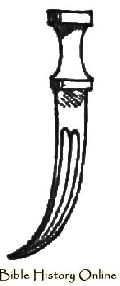
|
Persian Poniard With Damascened Blade And Ivory Handle
|
|
Persian poniard with damascened blade and ivory handle. |

|
Hindoo Khouttar With Blade
|
|
Hindoo khouttar with blade, called langue de boeuf. In the Museum of Artillery in Paris. |

|
Hindoo Khouttar With Forked Blade
|
|
Hindoo khouttar with forked blade. In the Museum of Tsarskoe-Selo. |

|
Turkish Kandjar Dagger
|
|
Turkish kandjar dagger. |

|
Javanese Krees
|
|
Javanese krees. |

|
Javanese Dagger But Of Indian Or Persian Workmanship
|
|
Javanese dagger but of Indian or Persian workmanship, 17 inches long. The blade is grooved and the handle of a massive piece of ivory, ornamented with nail heads in damascened iron. The sheath of shagreen is partly covered by plaques of niello-work. |
































































